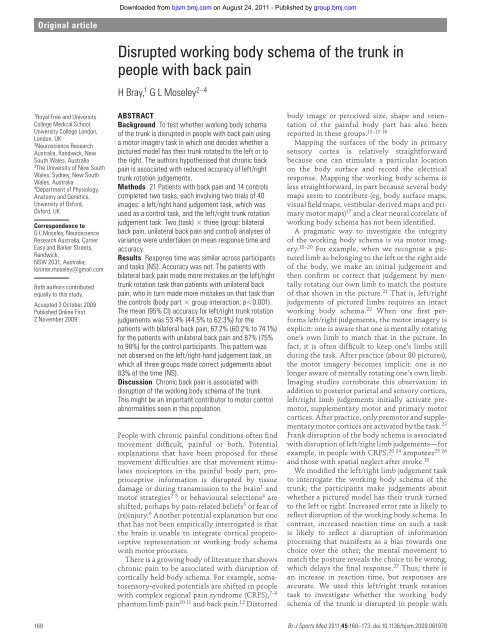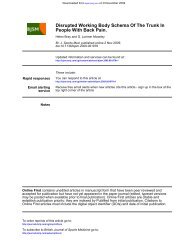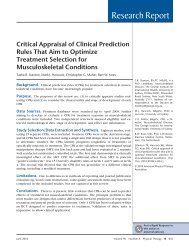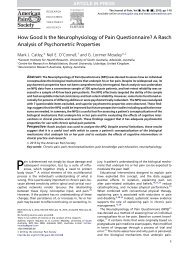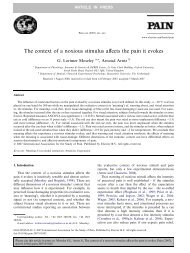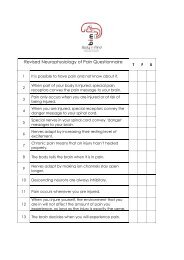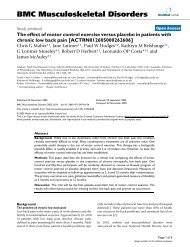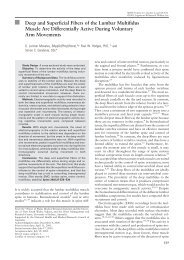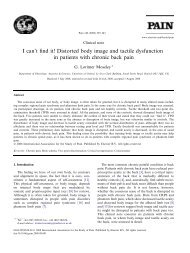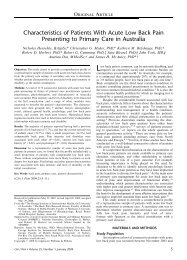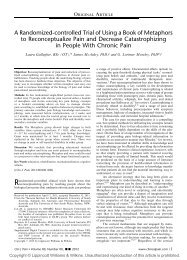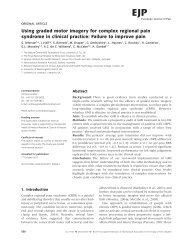Disrupted working body schema of the trunk in ... - Body in Mind
Disrupted working body schema of the trunk in ... - Body in Mind
Disrupted working body schema of the trunk in ... - Body in Mind
You also want an ePaper? Increase the reach of your titles
YUMPU automatically turns print PDFs into web optimized ePapers that Google loves.
Downloaded from bjsm.bmj.com on August 24, 2011 - Published by group.bmj.com<br />
Orig<strong>in</strong>al article<br />
<strong>Disrupted</strong> <strong>work<strong>in</strong>g</strong> <strong>body</strong> <strong>schema</strong> <strong>of</strong> <strong>the</strong> <strong>trunk</strong> <strong>in</strong><br />
people with back pa<strong>in</strong><br />
H Bray, 1 G L Moseley 2–4<br />
1 Royal Free and University<br />
College Medical School,<br />
University College London,<br />
London, UK<br />
2 Neuroscience Research<br />
Australia, Randwick, New<br />
South Wales, Australia<br />
3 The University <strong>of</strong> New South<br />
Wales, Sydney, New South<br />
Wales, Australia<br />
4 Department <strong>of</strong> Physiology,<br />
Anatomy and Genetics,<br />
University <strong>of</strong> Oxford,<br />
Oxford, UK<br />
Correspondence to<br />
G L Moseley, Neuroscience<br />
Research Australia, Corner<br />
Easy and Barker Streets,<br />
Randwick,<br />
NSW 2031, Australia;<br />
lorimer.moseley@gmail.com<br />
Both authors contributed<br />
equally to this study.<br />
Accepted 3 October 2009<br />
Published Onl<strong>in</strong>e First<br />
2 November 2009<br />
ABSTRACT<br />
Background To test whe<strong>the</strong>r <strong>work<strong>in</strong>g</strong> <strong>body</strong> <strong>schema</strong><br />
<strong>of</strong> <strong>the</strong> <strong>trunk</strong> is disrupted <strong>in</strong> people with back pa<strong>in</strong> us<strong>in</strong>g<br />
a motor imagery task <strong>in</strong> which one decides whe<strong>the</strong>r a<br />
pictured model has <strong>the</strong>ir <strong>trunk</strong> rotated to <strong>the</strong> left or to<br />
<strong>the</strong> right. The authors hypo<strong>the</strong>sised that chronic back<br />
pa<strong>in</strong> is associated with reduced accuracy <strong>of</strong> left/right<br />
<strong>trunk</strong> rotation judgements.<br />
Methods 21 Patients with back pa<strong>in</strong> and 14 controls<br />
completed two tasks, each <strong>in</strong>volv<strong>in</strong>g two trials <strong>of</strong> 40<br />
images: a left/right hand judgement task, which was<br />
used as a control task, and <strong>the</strong> left/right <strong>trunk</strong> rotation<br />
judgement task. Two (task) × three (group: bilateral<br />
back pa<strong>in</strong>, unilateral back pa<strong>in</strong> and control) analyses <strong>of</strong><br />
variance were undertaken on mean response time and<br />
accuracy.<br />
Results Response time was similar across participants<br />
and tasks (NS). Accuracy was not. The patients with<br />
bilateral back pa<strong>in</strong> made more mistakes on <strong>the</strong> left/right<br />
<strong>trunk</strong> rotation task than patients with unilateral back<br />
pa<strong>in</strong>, who <strong>in</strong> turn made more mistakes on that task than<br />
<strong>the</strong> controls (<strong>body</strong> part × group <strong>in</strong>teraction; p
Downloaded from bjsm.bmj.com on August 24, 2011 - Published by group.bmj.com<br />
Orig<strong>in</strong>al article<br />
back pa<strong>in</strong>. We hypo<strong>the</strong>sised that people with back pa<strong>in</strong> would<br />
make more errors on this task than people without back pa<strong>in</strong>.<br />
METHODS<br />
Informed consent was obta<strong>in</strong>ed from all <strong>the</strong> participants. All<br />
<strong>the</strong> procedures were approved by <strong>in</strong>stitutional ethics committees<br />
and conformed to <strong>the</strong> Hels<strong>in</strong>ki Declaration. First,<br />
we <strong>in</strong>terrogated <strong>the</strong> repeatability <strong>of</strong> this new task <strong>in</strong> patients<br />
and controls. Second, we undertook a cross-section study <strong>of</strong><br />
patients with back pa<strong>in</strong> and healthy controls.<br />
Repeatability <strong>of</strong> left/right <strong>trunk</strong> rotation judgement<br />
task <strong>in</strong> <strong>the</strong> patients and <strong>the</strong> controls<br />
A convenience sample <strong>of</strong> five patients with back pa<strong>in</strong> were<br />
recruited (one was male, and three were right-handed; mean<br />
(SD): age 46(16) years; duration <strong>of</strong> symptoms <strong>of</strong> this episode<br />
305 (561) weeks; duration s<strong>in</strong>ce <strong>the</strong> first episode 559 (620)<br />
weeks; 100 mm visual analogue scale (VAS) <strong>in</strong> response to <strong>the</strong><br />
question “What was your average pa<strong>in</strong> over <strong>the</strong> last 2 days?”<br />
46(23) mm). A convenience sample <strong>of</strong> five control participants<br />
without back pa<strong>in</strong> (two were male; 40(4) years) were also<br />
recruited.<br />
Control task: left/right judgements <strong>of</strong> pictured hands<br />
The participants undertook <strong>the</strong> left/right hand judgement task<br />
us<strong>in</strong>g <strong>the</strong> established protocol. 24 Fifteen photographs <strong>of</strong> a right<br />
hand <strong>in</strong> various postures were copied and digitally mirrored<br />
to produce photographs <strong>of</strong> a left hand <strong>in</strong> identical postures.<br />
Photographs were displayed <strong>in</strong> random order on a screen<br />
us<strong>in</strong>g commercially available s<strong>of</strong>tware (Recognise; Neuro<br />
Orthopaedic Institute, Adelaide, Australia; http://www.<br />
noigroup.com). The participants respond by press<strong>in</strong>g one button<br />
if <strong>the</strong> photograph shows a left hand and a different button<br />
if it shows a right hand. Emphasis is placed on <strong>the</strong> speed<br />
and accuracy <strong>of</strong> <strong>the</strong> responses. That is, <strong>the</strong>y are <strong>in</strong>structed to<br />
make accurate responses as quickly as possible. Forty pictures<br />
constituted a trial. Two trials constituted <strong>the</strong> task. The number<br />
<strong>of</strong> correct responses was expressed as a percentage <strong>of</strong> <strong>the</strong><br />
total number <strong>of</strong> pictures displayed and was called accuracy.<br />
The mean response time for correct responses (RT) was called<br />
response time. Thus, RT and accuracy were <strong>the</strong> primary outcome<br />
variables.<br />
Left/right <strong>trunk</strong> rotation judgements<br />
Twenty-eight photographs <strong>of</strong> a male model were taken <strong>in</strong> a<br />
variety <strong>of</strong> positions. In each position, <strong>the</strong> <strong>trunk</strong> was rotated to<br />
<strong>the</strong> right between 5° and 90°. The photographs were digitally<br />
mirrored to construct o<strong>the</strong>rwise identical pictures <strong>of</strong> <strong>the</strong> same<br />
model <strong>in</strong> various degrees <strong>of</strong> left rotation <strong>of</strong> <strong>the</strong> <strong>trunk</strong>. This<br />
produced a picture bank <strong>of</strong> 56 photographs, which was <strong>in</strong>tegrated<br />
<strong>in</strong>to <strong>the</strong> Recognise programme. The photographs were<br />
<strong>the</strong>n displayed <strong>in</strong> random order us<strong>in</strong>g Recognise. The participants<br />
responded by press<strong>in</strong>g one button if <strong>the</strong> photograph<br />
showed <strong>the</strong> model <strong>in</strong> left <strong>trunk</strong> rotation and a different button<br />
if it showed <strong>the</strong> model <strong>in</strong> right <strong>trunk</strong> rotation. Emphasis was<br />
aga<strong>in</strong> placed on <strong>the</strong> speed and <strong>the</strong> accuracy <strong>of</strong> <strong>the</strong> responses.<br />
Two trials <strong>of</strong> 40 images constituted <strong>the</strong> task. RT and accuracy<br />
were aga<strong>in</strong> <strong>the</strong> primary outcome variables.<br />
Protocol<br />
The participants sat <strong>in</strong> front <strong>of</strong> a monitor and keyboard with<br />
both forearms rest<strong>in</strong>g on <strong>the</strong> table. They positioned <strong>the</strong>mselves<br />
so that <strong>the</strong>y were comfortable. The <strong>in</strong>dex and middle<br />
f<strong>in</strong>ger <strong>of</strong> <strong>the</strong> dom<strong>in</strong>ant hand were placed on <strong>the</strong> appropriate<br />
response keys: “a” for left and “d” for right. The participants<br />
<strong>the</strong>n performed <strong>the</strong> left/right-hand judgement task and <strong>the</strong><br />
left/right <strong>trunk</strong> rotation task. The five patients and <strong>the</strong> five<br />
control participants completed <strong>the</strong> left/right judgements <strong>of</strong><br />
pictured hands and left/right <strong>trunk</strong> rotation judgement tasks <strong>in</strong><br />
five separate sessions, separated by at least 1 day (mean (range)<br />
4(1 to 7)). The order <strong>of</strong> <strong>the</strong> tasks was randomised and counterbalanced<br />
across <strong>the</strong> sessions. Each trial was preceded by a<br />
practice trial <strong>of</strong> 80 pictures.<br />
Statistical analyses<br />
All statistics were undertaken us<strong>in</strong>g SPSS V.11.0.0 (SPSS,<br />
Chicago, Ill<strong>in</strong>ois, USA). Four separate two-way random effects<br />
<strong>in</strong>traclass correlation coefficients (ICCs) were calculated: RT<br />
and accuracy for <strong>the</strong> patients and <strong>the</strong> controls.<br />
Experiment: is back pa<strong>in</strong> associated with <strong>in</strong>creased<br />
error rate <strong>of</strong> left/right <strong>trunk</strong> rotation judgements?<br />
A separate convenience sample <strong>of</strong> 21 patients with back pa<strong>in</strong><br />
(six were male, and 17 were right-handed; mean(SD): age<br />
44(13) years; duration <strong>of</strong> symptoms <strong>of</strong> this episode 122(296)<br />
weeks; duration s<strong>in</strong>ce <strong>the</strong> first episode 374(446) weeks; VAS<br />
<strong>of</strong> <strong>the</strong> present pa<strong>in</strong> <strong>in</strong>tensity, 0–100 mm from <strong>the</strong> left anchor,<br />
“no pa<strong>in</strong>” 37(21) mm) were recruited from a private physio<strong>the</strong>rapy<br />
practice (table 1). The participants were excluded<br />
if <strong>the</strong>y had systemic disease, visual or motor impairment<br />
<strong>in</strong>clud<strong>in</strong>g dyslexia, arm or leg pa<strong>in</strong> or abnormality or if <strong>the</strong>y<br />
were pregnant.<br />
Fourteen asymptomatic participants (five were male, and<br />
all were right-handed; 43(7) years) were recruited as healthy<br />
controls. Control participants were excluded if <strong>the</strong>y had back<br />
pa<strong>in</strong> or an episode <strong>of</strong> back pa<strong>in</strong> sufficient to limit activities<br />
<strong>of</strong> daily liv<strong>in</strong>g with<strong>in</strong> <strong>the</strong> past year; if <strong>the</strong>y had systemic disease,<br />
visual or motor impairment <strong>in</strong>clud<strong>in</strong>g dyslexia, arm or<br />
Table 1 ICCs for <strong>the</strong> left/right <strong>trunk</strong> rotation task and <strong>the</strong> left/right hand judgement task <strong>in</strong> <strong>the</strong> patients<br />
with back pa<strong>in</strong> and <strong>the</strong> healthy controls<br />
Task Measure Group F(14,56) Signifi cance ICC ICC 95% CI<br />
L/R <strong>trunk</strong> rotation RT Control 3.81 0.0002 0.738 0.447 to 0.900<br />
L/R <strong>trunk</strong> rotation RT Patient 7.84 0.0000 0.872 0.731 to 0.951<br />
L/R hands RT Control 21.35 0.0000 0.953 0.901 to 0.982<br />
L/R hands RT Patient 3.30 0.0007 0.697 0.360 to 0.884<br />
L/R <strong>trunk</strong> rotation Accuracy Control 5.09 0.0000 0.804 0.586 to 0.970<br />
L/R <strong>trunk</strong> rotation Accuracy Patient 12.50 0.0000 0.920 0.831 to 0.970<br />
L/R hands Accuracy Control 7.52 0.0000 0.867 0.737 to 0.944<br />
L/R hands Accuracy Patient 13.13 0.0000 0.924 0.849 to 0.968<br />
Accuracy, proportion <strong>of</strong> responses that are correct; L, left; R, right.<br />
Br J Sports Med 2011;45:168–173. doi:10.1136/bjsm.2009.061978 169
Downloaded from bjsm.bmj.com on August 24, 2011 - Published by group.bmj.com<br />
Orig<strong>in</strong>al article<br />
leg pa<strong>in</strong> or abnormality or if <strong>the</strong>y were pregnant. The controls<br />
were not specifically matched to <strong>the</strong> patients, but <strong>the</strong> age, sex<br />
mix, <strong>body</strong> mass <strong>in</strong>dex and activity level <strong>of</strong> <strong>the</strong> groups were<br />
evaluated.<br />
Assessments<br />
The patients completed <strong>the</strong> Short-Form McGill Pa<strong>in</strong><br />
Questionnaire 28 and <strong>the</strong> habitual physical activity questionnaire,<br />
29 both <strong>of</strong> which have established reliability and validity<br />
for back pa<strong>in</strong>. The control participants completed only <strong>the</strong><br />
habitual physical activity questionnaire.<br />
Protocol<br />
Demographic and cl<strong>in</strong>ical data were collected <strong>in</strong> an <strong>in</strong>terview<br />
and a standard full physical exam<strong>in</strong>ation was undertaken by<br />
a senior musculoskeletal physio<strong>the</strong>rapist (HB). These assessments<br />
determ<strong>in</strong>ed <strong>the</strong> location and <strong>the</strong> characteristics <strong>of</strong> <strong>the</strong><br />
participants’ back pa<strong>in</strong>. The participants <strong>the</strong>n completed <strong>the</strong><br />
questionnaires. The participants <strong>the</strong>n undertook <strong>the</strong> two left/<br />
right judgement tasks. The order <strong>of</strong> tasks was randomised and<br />
counterbalanced between <strong>the</strong> participants. Each trial was preceded<br />
by a practice trial <strong>of</strong> 80 pictures, and <strong>the</strong> participants sat<br />
quietly for 3 m<strong>in</strong> between trials.<br />
Statistical analysis<br />
To test <strong>the</strong> hypo<strong>the</strong>sis that left/right <strong>trunk</strong> rotation judgements<br />
are disrupted <strong>in</strong> patients with back pa<strong>in</strong>, we undertook<br />
two repeated measures analyses <strong>of</strong> variance, one on<br />
RT for correct judgements and one on accuracy. For each<br />
analysis <strong>of</strong> variance, <strong>the</strong> with<strong>in</strong>-participant factor was <strong>body</strong><br />
part (two levels: hand or <strong>trunk</strong>) and <strong>the</strong> between-participant<br />
factor was group (three levels: patients with unilateral back<br />
pa<strong>in</strong>, patients with bilateral back pa<strong>in</strong> and controls). We<br />
hypo<strong>the</strong>sised that patients with unilateral back pa<strong>in</strong> would<br />
perform worse than controls, and on <strong>the</strong> basis <strong>of</strong> <strong>the</strong> notion<br />
that a wider area <strong>of</strong> pa<strong>in</strong> would be associated with a wider<br />
disruption <strong>of</strong> <strong>the</strong> <strong>work<strong>in</strong>g</strong> <strong>body</strong> <strong>schema</strong>, we hypo<strong>the</strong>sised<br />
that those with bilateral back pa<strong>in</strong> would perform worse<br />
than those with unilateral back pa<strong>in</strong>.<br />
In <strong>the</strong> secondary analyses, l<strong>in</strong>ear regression was used to<br />
<strong>in</strong>vestigate <strong>the</strong> relationship between (1) duration <strong>of</strong> symptoms<br />
and (2) present pa<strong>in</strong> <strong>in</strong>tensity, as measured on <strong>the</strong> McGill Pa<strong>in</strong><br />
Questionnaire, and each <strong>of</strong> <strong>the</strong> primary outcome variables, RT<br />
and accuracy.<br />
RESULTS<br />
Repeatability <strong>of</strong> left/right <strong>trunk</strong> rotation judgement task<br />
The variance and <strong>the</strong> repeatability <strong>of</strong> both <strong>the</strong> RT and accuracy<br />
measures obta<strong>in</strong>ed from <strong>the</strong> left/right <strong>trunk</strong> rotation judgement<br />
task were acceptable for <strong>the</strong> patients and <strong>the</strong> controls<br />
and comparable with that <strong>of</strong> <strong>the</strong> established left/right hand<br />
judgement task. Table 1 shows <strong>the</strong> ICCs for both measures and<br />
both tasks.<br />
Experiment: is back pa<strong>in</strong> associated with disrupted<br />
left/right judgements <strong>of</strong> <strong>trunk</strong> rotation?<br />
Complete data sets were obta<strong>in</strong>ed from all <strong>the</strong> participants.<br />
The patient characteristics <strong>in</strong>clud<strong>in</strong>g pa<strong>in</strong> <strong>in</strong>tensity, duration<br />
and location are shown <strong>in</strong> table 2. The age, <strong>the</strong> sex mix, <strong>the</strong><br />
<strong>body</strong> mass <strong>in</strong>dex and <strong>the</strong> activity level <strong>of</strong> <strong>the</strong> groups were similar<br />
(p>0.27 for all).<br />
Reaction time for correct responses<br />
RT was affected nei<strong>the</strong>r by group nor by task. That is, patients<br />
with back pa<strong>in</strong> were nei<strong>the</strong>r slower nor quicker at ei<strong>the</strong>r task<br />
than <strong>the</strong> healthy controls (no ma<strong>in</strong> between-participants effect<br />
<strong>of</strong> group: F(2,36)=1.539, p=0.228; no ma<strong>in</strong> with<strong>in</strong>-participants<br />
effect <strong>of</strong> <strong>body</strong> part: F(1,36)=0.342, p=0.562). There was no<br />
<strong>body</strong> part × group <strong>in</strong>teraction (F(2,36)=2.209, p=0.146). The<br />
mean (95% confidence <strong>in</strong>terval (CI)) RT for left/right <strong>trunk</strong><br />
rotation judgements) was 2.4 seconds (2.2 to 2.6 seconds) for<br />
Table 2 Patient characteristics<br />
Age (years)/<br />
sex/dom<br />
Distribution<br />
<strong>of</strong> pa<strong>in</strong><br />
Duration <strong>of</strong> this<br />
episode (weeks)<br />
Duration s<strong>in</strong>ce fi rst<br />
episode (weeks) PPI (mm) SLR Diagnosis Reported medications<br />
32/M/R L 6 6 72 L L4/5 disc degen Paracetamol<br />
27/F/L R 156 312 62 NAD Facet disease None reported<br />
64/F/R Bilateral 1300 1300 50 NAD NSBP None reported<br />
49/F/L L 5 1144 17 NAD NSBP Dicl<strong>of</strong>enac<br />
58/F/R Bilateral 31 31 29 R Discetomy at 8 weeks Paracetamol<br />
45/M/L Bilateral 2 520 16 NAD NSBP None reported<br />
35/F/R Bilateral 130 130 11 NAD NSBP None reported<br />
41/F/R Bilateral 52 312 27 NAD L5/S1 fusion 6 weeks Ibupr<strong>of</strong>en + paracetamol<br />
62/F/R R 156 156 65 NAD AS at 31 years Neur<strong>of</strong>en<br />
57/F/R R 4 1040 10 NAD NSBP None reported<br />
28/F/R R 312 312 16 R Discectomy 6 years None reported<br />
54/F/R R 6 1144 14 NAD NSBP None reported<br />
18/F/R Bilateral 17 17 68 NAD NSBP Diazpam + cod<strong>in</strong>e<br />
38/F/R Bilateral 31 31 56 NAD NSBP None reported<br />
55/F/L L 23 156 29 NAD NSBP None reported<br />
37/M/R R 11 11 11 R L5/S1 disc degen None reported<br />
59/F/R R 18 468 20 NAD NSBP Paracetamol<br />
37/M/R Bilateral 12 56 4 R and L L4/5 disc degen Paracetamol + cod<strong>in</strong>e<br />
42/M/R Bilateral 7 31 5 R NSBP Ibupr<strong>of</strong>en<br />
47/M/R L 3 46 6 L NSBP Paracetamol + cod<strong>in</strong>e<br />
32/F/R R 4 4 4 NAD NSBP Ibupr<strong>of</strong>en + paracetamol<br />
AS, ankylos<strong>in</strong>g spondylitis; degen, degeneration accord<strong>in</strong>g to radiological fi nd<strong>in</strong>gs; Distribution <strong>of</strong> pa<strong>in</strong>, distribution <strong>of</strong> reported pa<strong>in</strong> as unilateral (left or right) or bilateral/central;<br />
Dom, dom<strong>in</strong>ant hand as reported by patient; F, female; L, left; M, male; NAD, no abnormality detected; NSBP, non-specifi c back pa<strong>in</strong>; PPI, present pa<strong>in</strong><br />
<strong>in</strong>tensity (0–100 mm VAS); R, right; SLR, straight leg raise test.<br />
170<br />
Br J Sports Med 2011;45:168–173. doi:10.1136/bjsm.2009.061978
Downloaded from bjsm.bmj.com on August 24, 2011 - Published by group.bmj.com<br />
Orig<strong>in</strong>al article<br />
patients with back pa<strong>in</strong> and 2.4 seconds (2.2 to 2.5 seconds) for<br />
<strong>the</strong> healthy controls.<br />
Accuracy <strong>of</strong> left/right <strong>trunk</strong> rotation judgements<br />
Accuracy was affected by <strong>the</strong> group and by <strong>the</strong> task (figure 1).<br />
That is, patients with bilateral back pa<strong>in</strong> made more errors<br />
overall than <strong>the</strong> controls (ma<strong>in</strong> between-participants effect <strong>of</strong><br />
group: F(2,36)=4.720, p
Downloaded from bjsm.bmj.com on August 24, 2011 - Published by group.bmj.com<br />
Orig<strong>in</strong>al article<br />
<strong>of</strong> usual pa<strong>in</strong> <strong>in</strong> patients with back pa<strong>in</strong>. 15 33 Importantly,<br />
this <strong>in</strong>crease <strong>in</strong> two-po<strong>in</strong>t discrim<strong>in</strong>ation threshold is positively<br />
related to a loss <strong>of</strong> voluntary lumbopelvic control. 33<br />
The representation <strong>in</strong> primary motor cortex <strong>of</strong> <strong>the</strong> deepest<br />
abdom<strong>in</strong>al muscle, an important muscular controller <strong>of</strong><br />
<strong>the</strong> lumbar sp<strong>in</strong>e, 34 is shifted <strong>in</strong> patients with back pa<strong>in</strong>. 35<br />
F<strong>in</strong>ally, perceptual characteristics are also distorted: when<br />
asked to draw <strong>the</strong> perceived outl<strong>in</strong>e <strong>of</strong> <strong>the</strong>ir back, patients<br />
with back pa<strong>in</strong> report that <strong>the</strong>y “can’t fi nd it” <strong>in</strong> <strong>the</strong> area <strong>of</strong><br />
<strong>the</strong>ir usual pa<strong>in</strong>. 15<br />
It has been suggested that disrupted cortical representations<br />
are actually a cause <strong>of</strong> ongo<strong>in</strong>g pathological pa<strong>in</strong>. 36 In<br />
phantom limb pa<strong>in</strong> and CRPS, <strong>the</strong> extent <strong>of</strong> S1 reorganisation<br />
correlates with pa<strong>in</strong> 37 and recovery is associated with<br />
normalisation <strong>of</strong> S1 organisation, 38–40 which lend support<br />
to this <strong>the</strong>ory. However, <strong>the</strong>re are also problems with this<br />
<strong>the</strong>ory: S1 holds maps <strong>of</strong> <strong>the</strong> surfaces <strong>of</strong> <strong>the</strong> <strong>body</strong>, and <strong>the</strong>se<br />
maps can be altered without caus<strong>in</strong>g pa<strong>in</strong> or disturb<strong>in</strong>g<br />
movement. 41 It is likely that <strong>the</strong> mechanisms that underp<strong>in</strong><br />
<strong>the</strong> change <strong>in</strong> somatosensory-evoked responses <strong>in</strong>duced by<br />
alter<strong>in</strong>g sensory <strong>in</strong>put 41 and those associated with chronic<br />
pathological pa<strong>in</strong> 37 are different. 42 However, if disrupted<br />
<strong>work<strong>in</strong>g</strong> <strong>body</strong> <strong>schema</strong> <strong>of</strong> <strong>the</strong> <strong>trunk</strong> contributes to back pa<strong>in</strong>,<br />
we would have expected to see a relationship between disruption<br />
<strong>of</strong> left/right <strong>trunk</strong> rotation judgement and present<br />
pa<strong>in</strong> <strong>in</strong>tensity, which we did not. Regardless <strong>of</strong> whe<strong>the</strong>r or<br />
not disrupted <strong>work<strong>in</strong>g</strong> <strong>body</strong> <strong>schema</strong> contributes directly to<br />
pa<strong>in</strong>, it has clear functional implications. For example, disrupted<br />
<strong>work<strong>in</strong>g</strong> <strong>body</strong> <strong>schema</strong> is likely to <strong>in</strong>troduce error <strong>in</strong><br />
motor commands, which will affect movement outcome and<br />
may predispose to <strong>in</strong>jury. F<strong>in</strong>ally, although <strong>the</strong> current work<br />
does not demonstrate a causative l<strong>in</strong>k between back pa<strong>in</strong> and<br />
disrupted <strong>work<strong>in</strong>g</strong> <strong>body</strong> <strong>schema</strong>, it raises <strong>the</strong> possibility that<br />
one exists, which <strong>in</strong> turn raises <strong>the</strong> possibility that <strong>the</strong>rapeutic<br />
strategies that normalise <strong>work<strong>in</strong>g</strong> <strong>body</strong> <strong>schema</strong> may be<br />
helpful <strong>in</strong> rehabilitation. Such a possibility seems worthy <strong>of</strong><br />
fur<strong>the</strong>r <strong>in</strong>vestigation.<br />
Interpretation <strong>of</strong> <strong>the</strong> current results should consider several<br />
limitations to this study. First, we recorded nei<strong>the</strong>r muscle<br />
activity nor autonomic response, so we cannot completely<br />
exclude peripheral mechanisms or autonomic <strong>in</strong>put as confounders,<br />
although <strong>the</strong>y seem unlikely. Experimentally manipulat<strong>in</strong>g<br />
muscle activity does not decrease accuracy on a left/<br />
right judgement task. 30 Second, we used a convenience sample<br />
<strong>of</strong> patients and healthy controls, which were not matched <strong>in</strong><br />
a participant-by-participant fashion, although <strong>the</strong> average age<br />
and proportion <strong>of</strong> males to females was similar.<br />
In summary, <strong>the</strong> patients with bilateral back pa<strong>in</strong> made<br />
more errors than those with unilateral back pa<strong>in</strong>, who <strong>in</strong> turn<br />
made more errors than <strong>the</strong> healthy controls, on a left/right<br />
<strong>trunk</strong> rotation task, but <strong>the</strong>y all performed similarly on a<br />
left/right hand judgement task. The reduced accuracy is probably<br />
mediated by disruption <strong>of</strong> <strong>the</strong> <strong>work<strong>in</strong>g</strong> <strong>body</strong> <strong>schema</strong> and<br />
<strong>in</strong>tegration <strong>of</strong> with motor processes, which raises implications<br />
for our understand<strong>in</strong>g and management <strong>of</strong> this patient<br />
group.<br />
Fund<strong>in</strong>g The Nuffi eld Oxford Medical Fellowship granted support to GLM. The<br />
National Health & Medical Research Council <strong>of</strong> Australia granted support to GLM.<br />
Compet<strong>in</strong>g <strong>in</strong>terests None.<br />
Patient consent Obta<strong>in</strong>ed.<br />
Ethics approval This study was conducted with <strong>the</strong> approval <strong>of</strong> <strong>the</strong> Royal Free and<br />
University College Medical School, University College London, London, UK.<br />
Provenance and peer review Not commissioned; externally peer reviewed.<br />
172<br />
REFERENCES<br />
1. Capra NF, Ro JY. Experimental muscle pa<strong>in</strong> produces central modulation <strong>of</strong><br />
proprioceptive signals aris<strong>in</strong>g from jaw muscle sp<strong>in</strong>dles. Pa<strong>in</strong> 2000;86:151–62.<br />
2. Watson PJ, Booker CK, Ma<strong>in</strong> CJ. Evidence for <strong>the</strong> role <strong>of</strong> psychological<br />
factors <strong>in</strong> abnormal parasp<strong>in</strong>al activity <strong>in</strong> patients with chronic low back pa<strong>in</strong>.<br />
J Musculoskelet Pa<strong>in</strong> 1997;5:41–56.<br />
3. Hodges PW, Richardson CA. Ineffi cient muscular stabilization <strong>of</strong> <strong>the</strong> lumbar<br />
sp<strong>in</strong>e associated with low back pa<strong>in</strong>. A motor control evaluation <strong>of</strong> transversus<br />
abdom<strong>in</strong>is. Sp<strong>in</strong>e 1996;21:2640–50.<br />
4. Estlander AM. Determ<strong>in</strong>ants <strong>of</strong> pa<strong>in</strong> behaviour <strong>in</strong> patients with chronic low back<br />
pa<strong>in</strong>. Ann Med 1989;21:381–5.<br />
5. Moseley GL, Hodges PW. Reduced variability <strong>of</strong> postural strategy prevents<br />
normalization <strong>of</strong> motor changes <strong>in</strong>duced by back pa<strong>in</strong>: a risk factor for chronic<br />
trouble? Behav Neurosci 2006;120:474–6.<br />
6. Vlaeyen JW, Crombez G. Fear <strong>of</strong> movement/(re)<strong>in</strong>jury, avoidance and pa<strong>in</strong><br />
disability <strong>in</strong> chronic low back pa<strong>in</strong> patients. Man Ther 1999;4:187–95.<br />
7. Juottonen K, Gockel M, Silén T, et al. Altered central sensorimotor process<strong>in</strong>g <strong>in</strong><br />
patients with complex regional pa<strong>in</strong> syndrome. Pa<strong>in</strong> 2002;98:315–23.<br />
8. Maihöfner C, Handwerker HO, Neundörfer B, et al. Patterns <strong>of</strong> cortical<br />
reorganization <strong>in</strong> complex regional pa<strong>in</strong> syndrome. Neurology 2003;61:1707–15.<br />
9. Pleger B, Ragert P, Schwenkreis P, et al. Patterns <strong>of</strong> cortical reorganization<br />
parallel impaired tactile discrim<strong>in</strong>ation and pa<strong>in</strong> <strong>in</strong>tensity <strong>in</strong> complex regional pa<strong>in</strong><br />
syndrome. Neuroimage 2006;32:503–10.<br />
10. Flor H, Elbert T, Knecht S, et al. Phantom-limb pa<strong>in</strong> as a perceptual correlate <strong>of</strong><br />
cortical reorganization follow<strong>in</strong>g arm amputation. Nature 1995;375:482–4.<br />
11. Knecht S, Henn<strong>in</strong>gsen H, Elbert T, et al. Cortical reorganization <strong>in</strong> human<br />
amputees and mislocalization <strong>of</strong> pa<strong>in</strong>ful stimuli to <strong>the</strong> phantom limb. Neurosci Lett<br />
1995;201:262–4.<br />
12. Flor H, Braun C, Elbert T, et al. Extensive reorganization <strong>of</strong> primary somatosensory<br />
cortex <strong>in</strong> chronic back pa<strong>in</strong> patients. Neurosci Lett 1997;224:5–8.<br />
13. Lewis JS, Kersten P, McCabe CS, et al. <strong>Body</strong> perception disturbance:<br />
a contribution to pa<strong>in</strong> <strong>in</strong> complex regional pa<strong>in</strong> syndrome (CRPS). Pa<strong>in</strong><br />
2007;133:111–9.<br />
14. Moseley GL. Distorted <strong>body</strong> image <strong>in</strong> complex regional pa<strong>in</strong> syndrome.<br />
Neurology 2005;65:773.<br />
15. Moseley GL. I can’t fi nd it! Distorted <strong>body</strong> image and tactile dysfunction <strong>in</strong><br />
patients with chronic back pa<strong>in</strong>. Pa<strong>in</strong> 2008;140:239–43.<br />
16. Lotze M, Moseley GL. Role <strong>of</strong> distorted <strong>body</strong> image <strong>in</strong> pa<strong>in</strong>. Curr Rheumatol Rep<br />
2007;9:488–96.<br />
17. Wolpert DM, Good<strong>body</strong> SJ, Husa<strong>in</strong> M. Ma<strong>in</strong>ta<strong>in</strong><strong>in</strong>g <strong>in</strong>ternal representations: <strong>the</strong><br />
role <strong>of</strong> <strong>the</strong> human superior parietal lobe. Nat Neurosci 1998;1:529–33.<br />
18. Coslett HB. Evidence for a disturbance <strong>of</strong> <strong>the</strong> <strong>body</strong> <strong>schema</strong> <strong>in</strong> neglect. Bra<strong>in</strong><br />
Cogn 1998;37:527–44.<br />
19. Funk M, Shiffrar M, Brugger P. Hand movement observation by <strong>in</strong>dividuals born<br />
without hands: phantom limb experience constra<strong>in</strong>s visual limb perception. Exp<br />
Bra<strong>in</strong> Res 2005;164:341–6.<br />
20. Schwoebel J, Friedman R, Duda N, et al. Pa<strong>in</strong> and <strong>the</strong> <strong>body</strong> <strong>schema</strong>:<br />
evidence for peripheral effects on mental representations <strong>of</strong> movement. Bra<strong>in</strong><br />
2001;124:2098–104.<br />
21. Parsons LM, Fox PT. The neural basis <strong>of</strong> implicit movements used <strong>in</strong> recognis<strong>in</strong>g<br />
hand shape. Cogn Neuropsychol 1998;15:583–615.<br />
22. Parsons LM. Integrat<strong>in</strong>g cognitive psychology, neurology and neuroimag<strong>in</strong>g.<br />
Acta Psychol 2001;107:155–81.<br />
23. Moseley GL, Schwe<strong>in</strong>hardt P, Wise R, et al. Virtual, imag<strong>in</strong>ed and mirror<br />
movements—a novel approach to complex regional pa<strong>in</strong> syndrome (CRPS1).<br />
Proceed<strong>in</strong>gs <strong>of</strong> European Federation <strong>of</strong> IASP Chapters Triennial Conference; 2–6<br />
September 2003, Prague, Czech Republic.<br />
24. Moseley GL. Why do people with complex regional pa<strong>in</strong> syndrome take longer to<br />
recognize <strong>the</strong>ir affected hand? Neurology 2004;62:2182–6.<br />
25. Moseley GL. Graded motor imagery for pathologic pa<strong>in</strong>: a randomized controlled<br />
trial. Neurology 2006;67:2129–34.<br />
26. Nico D, Daprati E, Rigal F, et al. Left and right hand recognition <strong>in</strong> upper limb<br />
amputees. Bra<strong>in</strong> 2004;127:120–32.<br />
27. Hudson ML, McCormick K, Zalucki N, et al. Expectation <strong>of</strong> pa<strong>in</strong> replicates <strong>the</strong><br />
effect <strong>of</strong> pa<strong>in</strong> <strong>in</strong> a hand laterality recognition task: bias <strong>in</strong> <strong>in</strong>formation process<strong>in</strong>g<br />
toward <strong>the</strong> pa<strong>in</strong>ful side? Eur J Pa<strong>in</strong> 2006;10:219–24.<br />
28. Melzack R. The Short-Form McGill Pa<strong>in</strong> Questionnaire. Pa<strong>in</strong> 1987;30:191–7.<br />
29. Baecke JA, Burema J, Frijters JE. A short questionnaire for <strong>the</strong> measurement<br />
<strong>of</strong> habitual physical activity <strong>in</strong> epidemiological studies. Am J Cl<strong>in</strong> Nutr<br />
1982;36:936–42.<br />
30. McCormick K, Zalucki N, Hudson M, et al. Faulty proprioceptive <strong>in</strong>formation<br />
disrupts motor imagery: an experimental study. Aust J Physio<strong>the</strong>r 2007;53:41–5.<br />
31. Schwoebel J, Coslett HB, Bradt J, et al. Pa<strong>in</strong> and <strong>the</strong> <strong>body</strong> <strong>schema</strong>:<br />
effects <strong>of</strong> pa<strong>in</strong> severity on mental representations <strong>of</strong> movement. Neurology<br />
2002;59:775–7.<br />
32. Moseley GL, Sim DF, Henry ML, et al. Experimental hand pa<strong>in</strong> delays recognition<br />
<strong>of</strong> <strong>the</strong> contralateral hand—evidence that acute and chronic pa<strong>in</strong> have opposite<br />
effects on <strong>in</strong>formation process<strong>in</strong>g? Bra<strong>in</strong> Res Cogn Bra<strong>in</strong> Res 2005;25:188–94.<br />
Br J Sports Med 2011;45:168–173. doi:10.1136/bjsm.2009.061978
Downloaded from bjsm.bmj.com on August 24, 2011 - Published by group.bmj.com<br />
Orig<strong>in</strong>al article<br />
33. Luomajoki H, Lorimer Moseley G. Tactile acuity and lumbopelvic motor control<br />
<strong>in</strong> patients with back pa<strong>in</strong> and healthy controls. Br J Sports Med. Published Onl<strong>in</strong>e<br />
First: 23 June 2009. doi:10.1136/bjsm.2009.060731.<br />
34. Hodges PW. Is <strong>the</strong>re a role for transversus abdom<strong>in</strong>is <strong>in</strong> lumbo-pelvic stability?<br />
Man Ther 1999;4:74–86.<br />
35. Tsao H, Galea MP, Hodges PW. Reorganization <strong>of</strong> <strong>the</strong> motor cortex is<br />
associated with postural control defi cits <strong>in</strong> recurrent low back pa<strong>in</strong>. Bra<strong>in</strong><br />
2008;131:2161–71.<br />
36. Harris AJ. Cortical orig<strong>in</strong> <strong>of</strong> pathological pa<strong>in</strong>. Lancet 1999;354:1464–6.<br />
37. Flor H, Nikolajsen L, Staehel<strong>in</strong> Jensen T. Phantom limb pa<strong>in</strong>: a case <strong>of</strong><br />
maladaptive CNS plasticity? Nat Rev Neurosci 2006;7:873–81.<br />
38. Maihöfner C, Handwerker HO, Neundörfer B, et al. Cortical reorganization dur<strong>in</strong>g<br />
recovery from complex regional pa<strong>in</strong> syndrome. Neurology 2004;63:693–701.<br />
39. Pleger B, Tegenth<strong>of</strong>f M, Ragert P, et al. Sensorimotor retun<strong>in</strong>g [corrected]<br />
<strong>in</strong> complex regional pa<strong>in</strong> syndrome parallels pa<strong>in</strong> reduction. Ann Neurol<br />
2005;57:425–9.<br />
40. Flor H, Denke C, Schaefer M, et al. Effect <strong>of</strong> sensory discrim<strong>in</strong>ation tra<strong>in</strong><strong>in</strong>g on<br />
cortical reorganisation and phantom limb pa<strong>in</strong>. Lancet 2001;357:1763–4.<br />
41. Moseley GL. Mak<strong>in</strong>g sense <strong>of</strong> S1 mania—are th<strong>in</strong>gs really that simple? In:<br />
Gifford L, ed. Topical issues <strong>in</strong> pa<strong>in</strong>. Vol 5. Falmouth: CNS Press, 2006:321–40.<br />
42. Kaas JH. Functional plasticity <strong>in</strong> adult cortex—<strong>in</strong>troduction. Sem<strong>in</strong> Neurosci<br />
1997;9:1.<br />
Br J Sports Med 2011;45:168–173. doi:10.1136/bjsm.2009.061978 173
Downloaded from bjsm.bmj.com on August 24, 2011 - Published by group.bmj.com<br />
<strong>Disrupted</strong> <strong>work<strong>in</strong>g</strong> <strong>body</strong> <strong>schema</strong> <strong>of</strong> <strong>the</strong> <strong>trunk</strong><br />
<strong>in</strong> people with back pa<strong>in</strong><br />
H Bray and G L Moseley<br />
Br J Sports Med 2011 45: 168-173 orig<strong>in</strong>ally published onl<strong>in</strong>e<br />
November 2, 2009<br />
doi: 10.1136/bjsm.2009.061978<br />
Updated <strong>in</strong>formation and services can be found at:<br />
http://bjsm.bmj.com/content/45/3/168.full.html<br />
References<br />
Email alert<strong>in</strong>g<br />
service<br />
These <strong>in</strong>clude:<br />
This article cites 40 articles, 10 <strong>of</strong> which can be accessed free at:<br />
http://bjsm.bmj.com/content/45/3/168.full.html#ref-list-1<br />
Receive free email alerts when new articles cite this article. Sign up <strong>in</strong><br />
<strong>the</strong> box at <strong>the</strong> top right corner <strong>of</strong> <strong>the</strong> onl<strong>in</strong>e article.<br />
Notes<br />
To request permissions go to:<br />
http://group.bmj.com/group/rights-licens<strong>in</strong>g/permissions<br />
To order repr<strong>in</strong>ts go to:<br />
http://journals.bmj.com/cgi/repr<strong>in</strong>tform<br />
To subscribe to BMJ go to:<br />
http://group.bmj.com/subscribe/


